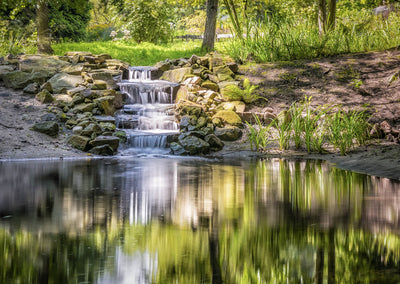October TIPS of the Month
There are many things you can do in October to ensure your property is ready for winter. Below are a list of To Dos:

Plant Your Garlic
The best time to plant garlic is in the late fall to about 2 weeks before the first frost. A quick internet search will give you your area's first frost date. Ensure your planting soil is well prepared with a mix of well rotted animal manure and compost. Plant your garlic cloves about 2 inches deep in the soil and cover with 2-3 inches of good mulch such as shredded leaves or straw. Note that when spring comes you will want to remove any heavy mulches to ensure your garlic does not suffocate under the weight.

Re-purpose Planter Soils
Remove and chop up dying back annual plants to add to your compost. What a great way to recycle! Unless your planter soil is packed with root wads, you can add this soil to your existing garden soils or set aside, protected for spring planter building. Planter soil is usually still viable as it contains all the ingredients for future annual planting. Alternatively, keep the soil in the planters and use them as a medium to stuff fall blooming, cold hardy plants for great fall color. You can also go hunting for winter planter foliage such as evergreen boughs and spent plants such as cattails, asparagus stalks, hydrangea blossoms, red osier dogwood and yellow willow branches, mullein stalks and whatever else you can find in the field that will add artistic flare to a winter planter! You can also add pine cones, rocks and other unique bounty from nature. Some craft stores also provide artificial plants that you can also add but often these items are expensive. There are many example of winter planters on the internet. Winter planters don't need watering or weeding; just enjoy all the way to spring!

Plant Bulbs
Spring bulbs give huge seasonal color and provide early pollinators with a banquet of diverse foods! You can now plant spring bulbs in your gardens and even your planters.

Plant Pansies
Who can argue with the amazing array of colors produced by pansies? Not only do they look amazing but they love cooler weather. They will bloom right up to frost.

Spray Copper on Soft Fruit Tree Tips
It is important to spray your fruit trees in the fall with copper fungicide and horticultural oil as soon as all the leaves have dropped. Copper fungicide works to kill pathogen cells by denaturing or changing enzymes. This helps control leaf curl, bacterial blight and other fungal diseases that can overwinter, as well as insects and their eggs. Copper fungicide won't cure an existing fungal disease in your fruit trees rather it is a preventative measure. If you have fungus on your fruit trees or vegetable plants, you can safely spray every 7-10 days until harvest. Ensure that you spray when you have at least 12 hours of dry weather. Be careful that do not over spray with copper as it can kill plant cells if absorbed in high enough quantities. Copper injury often shows in new spring leaves and leaf edges.
Horticultural oil or dormant oil is used to control insect pests such as aphids, leaf hoppers, scale and mites on fruit trees. Dormant oil can also be used to help control powdery mildew. It is safe to use as it is not harmful to pollinators and is even safe for humans and pets to ingest although we don't recommend doing that. The oil doesn't leave a toxic residue and it dissipates quickly in the environment. The oil covers leaves and limbs essentially suffocating insects and some insect eggs. It also can interfere with insect feeding.
Before using copper fungicide and dormant oil be sure to read and follow the labels carefully and ensure you understand the rates of application for your area and crop. A good rule of thumb is to avoid spraying on sunny days and when temperatures are freezing or close to freezing. Watch the weather outlook to plan your spray times. Note that drought-stressed plants are more susceptible to oil damage but applying during very humid conditions can reduce the rate of evaporation thereby causing burning.

Remove Left Over Fruit on Fruit Trees
Leftover fruit on a fruit tree is not a good thing because often old fruit is full of fungal infection that has colonized the fruit. Such an infestation can occur at any time during fruit development. Exercising proper tree hygiene means removing all left over fruit from your fruit tree and avoiding composting them. Rather, burn off the left over fruit or carefully place in a black plastic bag and dispose in the garbage. If you don't do this fungal spores will spend the winter on your fruit tree and may infect new fruits in the following year. The fungal spores can easily be carried on the wind and threaten an entire orchard.

Plant Next Seasons Shrubs and Perennials
October is a perfect time to pick up discounted, end of season plants from garden centers and nurseries. They may not be perfect looking specimens right now but next year they will look great again. Be sure your soil is well prepped for planting and that the plants you select are hardy for your area. You can protect newly planted perennials and trees by mulching.
![]() If you would like to know more TIPS about a certain gardening topic, let us know! Education and teaching are two of our most favorite things we do! We are always open to new ideas, stories and science-based, gardening-related information.
If you would like to know more TIPS about a certain gardening topic, let us know! Education and teaching are two of our most favorite things we do! We are always open to new ideas, stories and science-based, gardening-related information.





